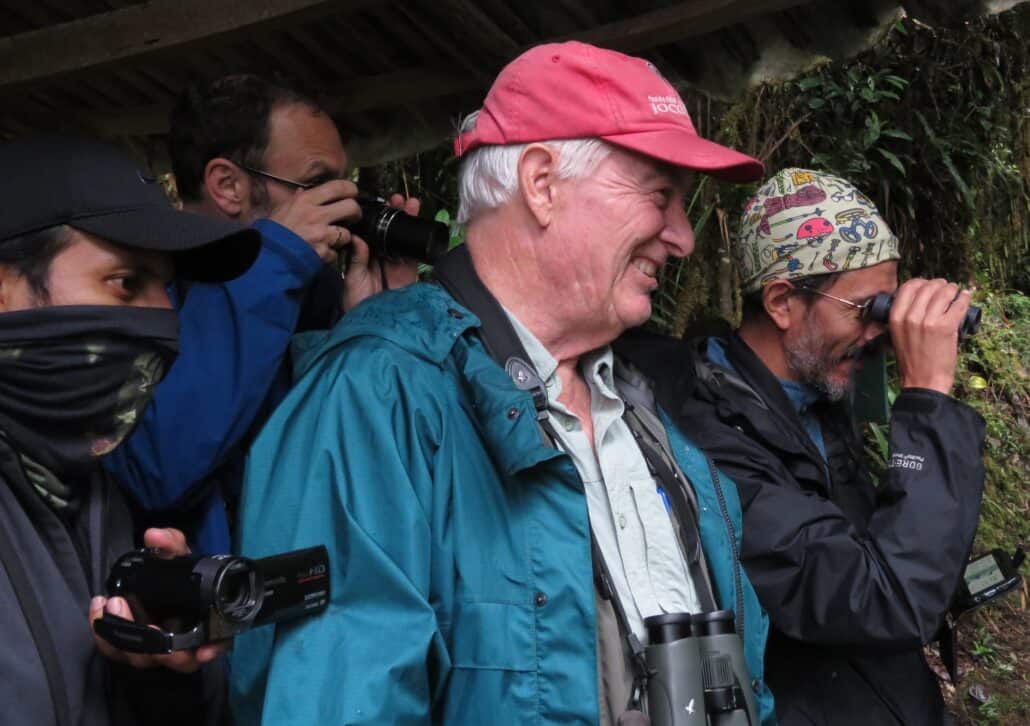In November 1997, an incredible finding ignited a conservation movement. Twenty years later, its founders retell their stories and motivations.
The coronation of 20 years of research to complete the book The Birds of Ecuador (published in 2001) was a short trip to record bird songs. John Moore, his wife Ruth Moore, Lelis Navarrete, and Mercedes Rivadeneira joined Robert Ridgley, the book’s author (and future founder of Jocotoco Foundation), on a trip to Quebrada Honda, below Nudo de Sabanilla and Cerro Tapichalaca in the East Andean slope of Ecuador.

According to Robert Ridgely, “November 20th, 1997: After dawn, Lelis and I heard this bird, too far away to be recorded. At 11 o’clock, the bird called again in the bamboo, close to me. It was loud, and I immediately recorded it. We knew it was something really interesting, but had no clue what it was. I played the recording, and the bird crashed abruptly and rapidly from the bamboo. And there it was, right in front of us—the entire group this time! We knew we had something really, really good. I played the recording again, and the bird started to sing, hopped down, right in the open. I’ve never seen that again!
“Making it even more incredible, a second individual came out! It was a female. I think it was meant to be. We made a detailed description talking into my cassette recorder, and patted our backs.

“We changed our plans and returned to photograph the bird the following day. We were unsuccessful; weather conditions were not good. We went back a third time the following day because this was arguably the most exciting new Ecuadorian bird discovered since the 1920s. This time, I was able to photograph it, but didn’t know what I had gotten until I was back in the U.S.
“People would call me to listen to the recording. I would play it over the phone. The excitement was growing…”
Nigel Simpson continues: “David Agro passed to me the exciting news of Bob’s amazing discovery. I asked David which of the antpittas in Bob’s textbook Birds of South America it resembled. David said it was like none of them! We immediately planned to go, and met in Quito on January 10, 1998. I was happy to fund this very successful expedition to Cerro Tapichalaca.
“We decided on purchasing the site where the antpitta resided. The local farmers—who called this bird “jocotoco”—agreed to sell; none lived there given the rough weather conditions. We started to establish a foundation in Ecuador to become the owners of the land and to employ local people as rangers. I created a charitable foundation in the UK to fund this project. My charity was approved in June 1998, and soon, the first large forest at Tapichalaca was purchased.
“The Jocotoco Foundation in Ecuador was approved in January 1999. Bob, John Moore, Lelis Navarette, Francisco Sornoza, and I revisited Tapichalaca and other sites in the south of Ecuador. These sites are now the Buenaventura and Jorupe reserves of Fundacion Jocotoco. John Moore joined me as a co-funder, and has continued ever since.”
Today the Jocotoco Foundation owns 12 nature reserves throughout Ecuador, which protect 52,000 acres that are home to 900 bird species, including 55 endangered species. It maintains five tourist lodges in unique ecosystems, and its partner company, Jocotours, provides nature and birding tours at the reserves.
For more information on the Jocotoco Foundation, see fjocotoco.org.
For more information on Jocotours, see jocotoursecuador.com.




